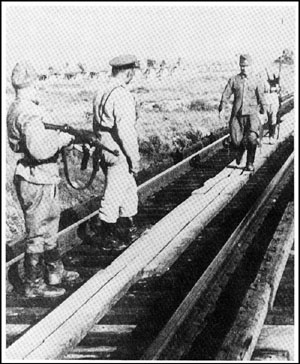
Transbaikal Front
Encyclopedia

Transbaikal Military District
The Transbaikal Military District was a military district of first the Military of the Soviet Union and then the Armed Forces of the Russian Federation, formed on May 17, 1935 and included the Buryat Republic, Chita Oblast, and Yakutia. Chita was the headquarters of the district...
. Initially, it included the 17th
17th Army (Soviet Union)
The 17th Army of the Red Army was a Soviet field army. It was formed from the 1st Army Group of the Transbaikal Military District on 21 July 1940 . From 1941 to 1945, the army assumed a general defensive posture, including within Mongolia...
and 36th armies, but in August 1942 the 12th Air Army was added to the front, and, finally, in June-July 1945 the 39th and the 53rd armies, the 6th Guards Tank Army
6th Guards Tank Army
The 6th Guards Order of Red Banner Tank Army was a tank army of the Soviet Union's Red Army, first formed during World War II and disbanded in Ukraine in the 1990s after the dissolution of the Soviet Union....
, and the Soviet Mongolian Cavalry Mechanized Group
Cavalry Mechanized Group
A cavalry-mechanized group was a type of military formation used in the Red Army during World War II against Germany and Japan.- Organization :...
under Issa Pliyev
Issa Pliyev
Issa Alexandrovich Pliyev was a Soviet military commander, Army General , twice Hero of the Soviet Union , Hero of the Mongolian People's Republic . Member of the CPSU since 1926. He was an ethnic Ossetian....
.
From September, 1941 to January, 1945 the Transbaikal Front sent to the Soviet fronts in Europe
Europe
Europe is, by convention, one of the world's seven continents. Comprising the westernmost peninsula of Eurasia, Europe is generally 'divided' from Asia to its east by the watershed divides of the Ural and Caucasus Mountains, the Ural River, the Caspian and Black Seas, and the waterways connecting...
about 300,000 personnel, 1,440 tanks, and 2,230 guns.
Soviet invasion of Manchuria
The armies and corps of the front under Rodion MalinovskyRodion Malinovsky
Rodion Yakovlevich Malinovsky was a Soviet military commander in World War II and Defense Minister of the Soviet Union in the late 1950s and 1960s. He contributed to the major defeat of Nazi Germany at the Battle of Stalingrad and the Battle of Budapest...
participated in the Soviet invasion of Manchuria during August, 1945 defeating the Kwantung Army of the Imperial Japanese Army
Imperial Japanese Army
-Foundation:During the Meiji Restoration, the military forces loyal to the Emperor were samurai drawn primarily from the loyalist feudal domains of Satsuma and Chōshū...
. The fighting had lasted for only about a week when Japan's Emperor Hirohito
Hirohito
, posthumously in Japan officially called Emperor Shōwa or , was the 124th Emperor of Japan according to the traditional order, reigning from December 25, 1926, until his death in 1989. Although better known outside of Japan by his personal name Hirohito, in Japan he is now referred to...
read the Gyokuon-hōsō
Gyokuon-hoso
The , lit. "Jewel Voice Broadcast", was the radio broadcast in which Japanese emperor Hirohito read out the , announcing to the Japanese people that the Japanese Government had accepted the Potsdam Declaration demanding the unconditional surrender of the Japanese military at the end of World War II...
on August 15 and declared a ceasefire in the region August 16. Soviet forces were already penetrating deep into Manchukuo by that time. They continued their largely unopposed advance into Manchukuo's territory, reaching Mukden, Changchun and Qiqihar by August 20. At the same time, Mengjiang was invaded by the Red Army and her Mongol allies, with Guihua quickly taken. The Emperor of Manchukuo (and the former Emperor of China), Puyi
Puyi
Puyi , of the Manchu Aisin Gioro clan, was the last Emperor of China, and the twelfth and final ruler of the Qing Dynasty. He ruled as the Xuantong Emperor from 1908 until his abdication on 12 February 1912. From 1 to 12 July 1917 he was briefly restored to the throne as a nominal emperor by the...
, was captured by the Soviet Red Army and transitted to Chita.
After the operation on October 9, 1945 the Transbaikal Front was disbanded and reorganized into the Transbaikal Military District.
Commander-in-chiefs of the front
- Mikhail KovalyovMikhail KovalyovColonel-General Mikhail Prokofievich Kovalyov was a Soviet military officer.Mikhail Kovalyov was born to family of a peasants in stanitsa Bryukovetskaya, Krasnodar Krai. In 1915 he enlisted in the Russian Army. After graduating from a School for Praporshchiks Kovalyov fought in World War I...
(July, 1941 to July, 1945) - Rodion MalinovskyRodion MalinovskyRodion Yakovlevich Malinovsky was a Soviet military commander in World War II and Defense Minister of the Soviet Union in the late 1950s and 1960s. He contributed to the major defeat of Nazi Germany at the Battle of Stalingrad and the Battle of Budapest...
(July, 1945 to October, 1945)

